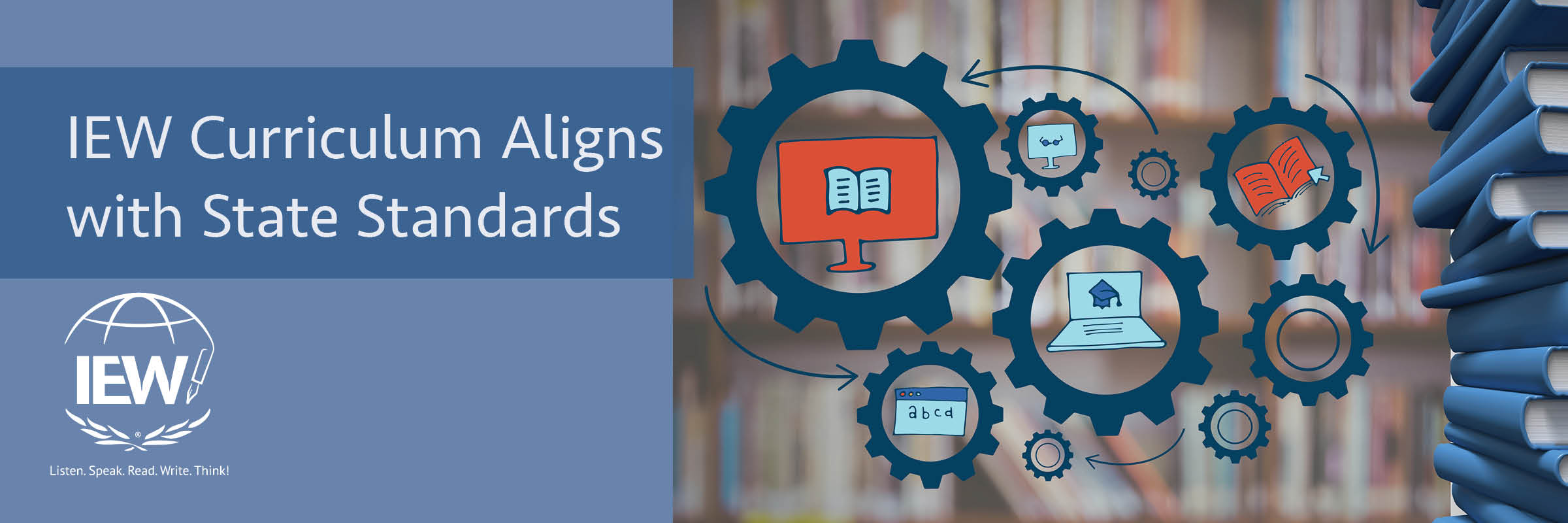
School teachers and curriculum directors often call IEW’s Schools Division asking if our curriculum meets state educational standards. Some schools or charter schools are not allowed to recommend items if they are not aligned with state standards, so it is important to have these standards. Additionally, teachers who have autonomy to choose curriculum for their classrooms sometimes need to provide standards documentation to their administrators. Furthermore, some homeschooling families may be required by their state to prove their curriculum is aligned with state standards. In early 2024, IEW contracted with EdGate, a nationally recognized company that offers comprehensive educational standards and alignment services, to provide state standards correlations for Adventures in Writing, Structure and Style® for Students, and Fix It!™ Grammar.
What are educational standards?
All fifty states, the District of Columbia, and many US territories have adopted a set of core academic standards that detail grade-level learning goals designed to ensure high school graduates acquire the necessary English language arts (ELA)/literacy and mathematics skills and knowledge for college and career readiness. The majority of these states and territories follow Common Core State Standards, which were developed in 2009 by a coordinated, state-led effort by the Council of Chief State School Officers and the National Governors Association Center for Best Practices. The nine states that did not adopt the Common Core State Standards each individually adopted their own set of core standards to inform instruction in their states.
Why are educational standards useful?
Grade-level educational standards provide teachers and administrators with clear and measurable outcomes for what students should be able to do at each grade level. The standards inform instruction. They do not, however, dictate how teachers should teach. Local school districts, administrators, and teachers decide the best methods and curriculum for their schools and classrooms. Finally, the standards help measure achievement. Districts, school administrators, and teachers can measure student success, both individually and collectively, based on these common goals.
What are the English Language Arts/Literacy Standards?
The standards for English language arts include outcomes for reading, writing, speaking, listening, and critical thinking skills in the ELA classroom. They also encompass literacy standards for history/social studies, science, and technical subjects because students must use language effectively in all content areas. The skills and knowledge in the ELA/literacy standards comprise critical thinking skills and involve attentively reading texts so that students learn reasoning and evidence collection skills. The standards are meant to define what it means to be a literate person who is prepared for college and career.
Who is EdGate?
According to the company’s website, “EdGate has been around for twenty-five years, collecting standards and maintaining them, building taxonomies and creating metadata, building tools, and filing for patents. Our work has been aiding publishers, EdTech companies and educators, allowing them to do what they do better.” IEW began working with EdGate in 2012 when the company first provided standards for the Structure and Style methodology and the Schools Division Primary Writing Lessons.
How does IEW curriculum align to educational standards?
EdGate provided standards correlations for Adventures in Writing, Structure and Style for Students, and Fix It! Grammar. The standards included on our website for kindergarten through second grade were completed in 2012 when EdGate reviewed the Classroom Supplements for IEW’s Primary Writing Lessons.
Adventures in Writing was used for third grade standards.
Structure and Style® for Students (SSS) levels correspond to the following grade levels:
SSS-1A - Grade 4
SSS-2A - Grade 5
SSS-1B - Grade 6
SSS-2B - Grade 7
SSS-3B - Grade 8 (will be provided upon completion of SSS-3B anticipated summer 2024)
SSS-1C - Grade 9
SSS-2C - Grade 10
Fix It!™ Grammar grade level correlations are as follows:
Level 1 – Grade 4
Level 2 – Grade 5
Level 3 – Grade 6
Level 4 – Grade 7
Level 5 – Grade 8
Level 6 – Grade 9
Although EdGate used Structure and Style for Students curriculum to provide the state-by-state standards alignment, they also included a state-by-state correlation of the IEW methodology to specific state standards. All the standards listed are met by the specific unit and stylistic technique taught within that unit regardless of source text. Thus, additional standards could be met by choosing source texts that cover certain content standards. While the IEW® curriculum is generally associated with writing and grammar skills, the Structure and Style method also cultivates reading, speaking, listening, and critical thinking skills.
How do you find and read EdGate’s state-by-state grade-level correlation reports?
EdGate’s state standards correlation reports can be found here. Once you choose your state, you will find grade-level alignments for the appropriate IEW structural unit and Fix It! Grammar correlation.
For the Primary Writing Lessons and Structure and Style for Students curriculum, the standards correlations are listed for each IEW structural unit. For Adventures in Writing third grade standards, the standards correlations are provided for each assignment. The Fix It! Grammar section is organized by standard, and the report lists the week(s) the standard is addressed because concepts are taught and then practiced and reviewed in subsequent lessons.
If you have questions about IEW curriculum and state standards alignment, please contact us. Schoolteachers can contact their Educational Consultants. Teaching parents, tutors, and other homeschool instructors can contact customer service.
by Andrea Pewthers
